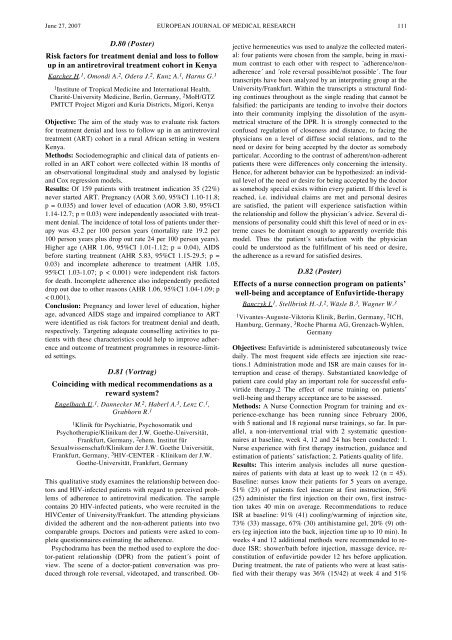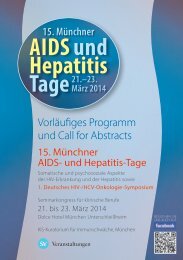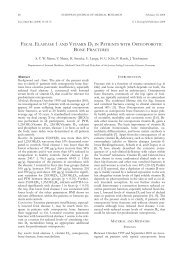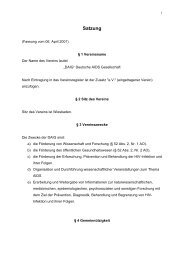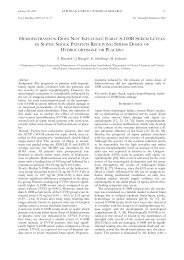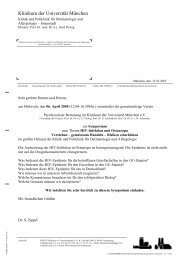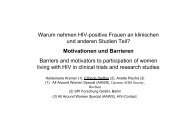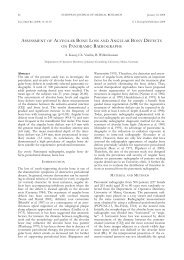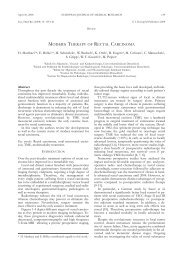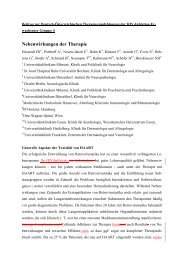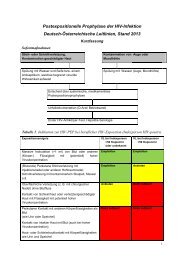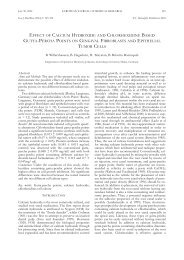European Journal of Medical Research - Deutsche AIDS ...
European Journal of Medical Research - Deutsche AIDS ...
European Journal of Medical Research - Deutsche AIDS ...
You also want an ePaper? Increase the reach of your titles
YUMPU automatically turns print PDFs into web optimized ePapers that Google loves.
June 27, 2007 EUROPEAN JOURNAL OF MEDICAL RESEARCH<br />
111<br />
D.80 (Poster)<br />
Risk factors for treatment denial and loss to follow<br />
up in an antiretroviral treatment cohort in Kenya<br />
Karcher H. 1 , Omondi A. 2 , Odera J. 2 , Kunz A. 1 , Harms G. 1<br />
1 Institute <strong>of</strong> Tropical Medicine and International Health,<br />
Charité-University Medicine, Berlin, Germany, 2 MoH/GTZ<br />
PMTCT Project Migori and Kuria Districts, Migori, Kenya<br />
Objective: The aim <strong>of</strong> the study was to evaluate risk factors<br />
for treatment denial and loss to follow up in an antiretroviral<br />
treatment (ART) cohort in a rural African setting in western<br />
Kenya.<br />
Methods: Sociodemographic and clinical data <strong>of</strong> patients enrolled<br />
in an ART cohort were collected within 18 months <strong>of</strong><br />
an observational longitudinal study and analysed by logistic<br />
and Cox regression models.<br />
Results: Of 159 patients with treatment indication 35 (22%)<br />
never started ART. Pregnancy (AOR 3.60, 95%CI 1.10-11.8;<br />
p = 0.035) and lower level <strong>of</strong> education (AOR 3.80, 95%CI<br />
1.14-12.7; p = 0.03) were independently associated with treatment<br />
denial. The incidence <strong>of</strong> total loss <strong>of</strong> patients under therapy<br />
was 43.2 per 100 person years (mortality rate 19.2 per<br />
100 person years plus drop out rate 24 per 100 person years).<br />
Higher age (AHR 1.06, 95%CI 1.01-1.12; p = 0.04), <strong>AIDS</strong><br />
before starting treatment (AHR 5.83, 95%CI 1.15-29.5; p =<br />
0.03) and incomplete adherence to treatment (AHR 1.05,<br />
95%CI 1.03-1.07; p < 0.001) were independent risk factors<br />
for death. Incomplete adherence also independently predicted<br />
drop out due to other reasons (AHR 1.06, 95%CI 1.04-1.09; p<br />
< 0.001).<br />
Conclusion: Pregnancy and lower level <strong>of</strong> education, higher<br />
age, advanced <strong>AIDS</strong> stage and impaired compliance to ART<br />
were identified as risk factors for treatment denial and death,<br />
respectively. Targeting adequate counselling activities to patients<br />
with these characteristics could help to improve adherence<br />
and outcome <strong>of</strong> treatment programmes in resource-limited<br />
settings.<br />
D.81 (Vortrag)<br />
Coinciding with medical recommendations as a<br />
reward system?<br />
Engelbach U. 1 , Dannecker M. 2 , Haberl A. 3 , Lenz C. 1 ,<br />
Grabhorn R. 1<br />
1 Klinik für Psychiatrie, Psychosomatik und<br />
Psychotherapie/Klinikum der J.W. Goethe-Universität,<br />
Frankfurt, Germany, 2 ehem. Institut für<br />
Sexualwissenschaft/Klinikum der J.W. Goethe Universität,<br />
Frankfurt, Germany, 3 HIV-CENTER - Klinikum der J.W.<br />
Goethe-Universität, Frankfurt, Germany<br />
This qualitative study examines the relationship between doctors<br />
and HIV-infected patients with regard to perceived problems<br />
<strong>of</strong> adherence to antiretroviral medication. The sample<br />
contains 20 HIV-infected patients, who were recruited in the<br />
HIVCenter <strong>of</strong> University/Frankfurt. The attending physicians<br />
divided the adherent and the non-adherent patients into two<br />
comparable groups. Doctors and patients were asked to complete<br />
questionnaires estimating the adherence.<br />
Psychodrama has been the method used to explore the doctor-patient<br />
relationship (DPR) from the patient´s point <strong>of</strong><br />
view. The scene <strong>of</strong> a doctor-patient conversation was produced<br />
through role reversal, videotaped, and transcribed. Ob-<br />
jective hermeneutics was used to analyze the collected material:<br />
four patients were chosen from the sample, being in maximum<br />
contrast to each other with respect to ´adherence/nonadherence´<br />
and ´role reversal possible/not possible´. The four<br />
transcripts have been analyzed by an interpreting group at the<br />
University/Frankfurt. Within the transcripts a structural finding<br />
continues throughout as the single reading that cannot be<br />
falsified: the participants are tending to involve their doctors<br />
into their community implying the dissolution <strong>of</strong> the asymmetrical<br />
structure <strong>of</strong> the DPR. It is strongly connected to the<br />
confused regulation <strong>of</strong> closeness and distance, to facing the<br />
physicians on a level <strong>of</strong> diffuse social relations, and to the<br />
need or desire for being accepted by the doctor as somebody<br />
particular. According to the contrast <strong>of</strong> adherent/non-adherent<br />
patients there were differences only concerning the intensity.<br />
Hence, for adherent behavior can be hypothesized: an individual<br />
level <strong>of</strong> the need or desire for being accepted by the doctor<br />
as somebody special exists within every patient. If this level is<br />
reached, i.e. individual claims are met and personal desires<br />
are satisfied, the patient will experience satisfaction within<br />
the relationship and follow the physician´s advice. Several dimensions<br />
<strong>of</strong> personality could shift this level <strong>of</strong> need or in extreme<br />
cases be dominant enough to apparently override this<br />
model. Thus the patient´s satisfaction with the physician<br />
could be understood as the fulfillment <strong>of</strong> his need or desire,<br />
the adherence as a reward for satisfied desires.<br />
D.82 (Poster)<br />
Effects <strong>of</strong> a nurse connection program on patients’<br />
well-being and acceptance <strong>of</strong> Enfuvirtide-therapy<br />
Banczyk I. 1 , Stellbrink H.-J. 2 , Wäsle B. 3 , Wagner W. 3<br />
1 Vivantes-Auguste-Viktoria Klinik, Berlin, Germany, 2 ICH,<br />
Hamburg, Germany, 3 Roche Pharma AG, Grenzach-Wyhlen,<br />
Germany<br />
Objectives: Enfuvirtide is administered subcutaneously twice<br />
daily. The most frequent side effects are injection site reactions.1<br />
Administration mode and ISR are main causes for interruption<br />
and cease <strong>of</strong> therapy. Substantiated knowledge <strong>of</strong><br />
patient care could play an important role for successful enfuvirtide<br />
therapy.2 The effect <strong>of</strong> nurse training on patients’<br />
well-being and therapy acceptance are to be assessed.<br />
Methods: A Nurse Connection Program for training and experience-exchange<br />
has been running since February 2006,<br />
with 5 national and 18 regional nurse trainings, so far. In parallel,<br />
a non-interventional trial with 2 systematic questionnaires<br />
at baseline, week 4, 12 and 24 has been conducted: 1.<br />
Nurse experience with first therapy instruction, guidance and<br />
estimation <strong>of</strong> patients’ satisfaction; 2. Patients quality <strong>of</strong> life.<br />
Results: This interim analysis includes all nurse questionnaires<br />
<strong>of</strong> patients with data at least up to week 12 (n = 45).<br />
Baseline: nurses know their patients for 5 years on average,<br />
51% (23) <strong>of</strong> patients feel insecure at first instruction, 56%<br />
(25) administer the first injection on their own, first instruction<br />
takes 40 min on average. Recommendations to reduce<br />
ISR at baseline: 91% (41) cooling/warming <strong>of</strong> injection site,<br />
73% (33) massage, 67% (30) antihistamine gel, 20% (9) others<br />
(eg injection into the back, injection time up to 10 min). In<br />
weeks 4 and 12 additional methods were recommended to reduce<br />
ISR: shower/bath before injection, massage device, reconstitution<br />
<strong>of</strong> enfuvirtide powder 12 hrs before application.<br />
During treatment, the rate <strong>of</strong> patients who were at least satisfied<br />
with their therapy was 36% (15/42) at week 4 and 51%


